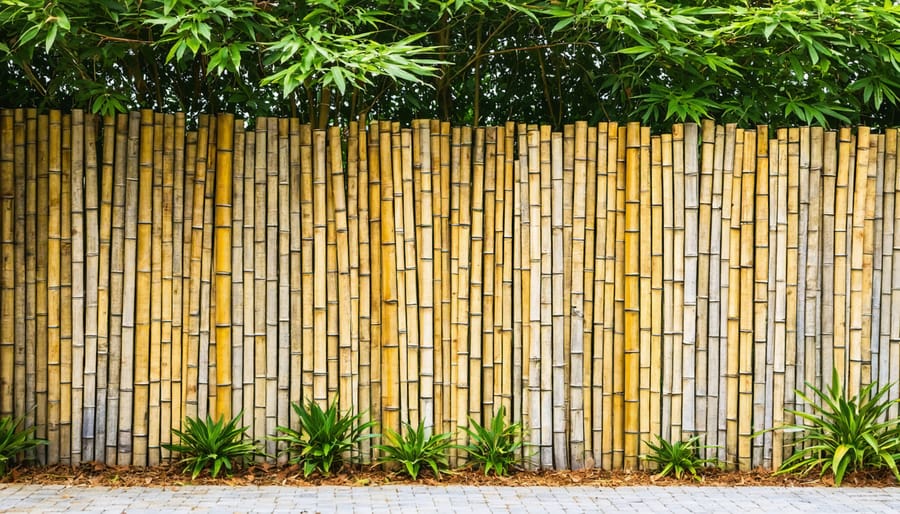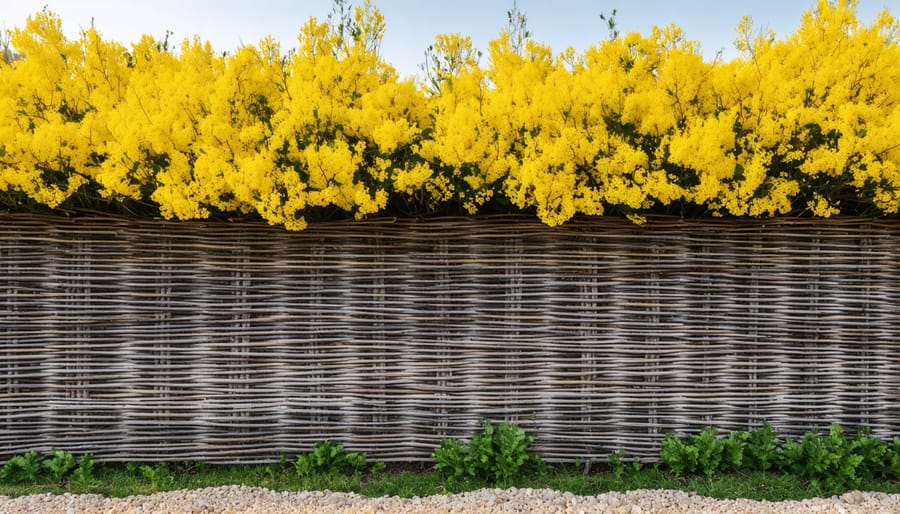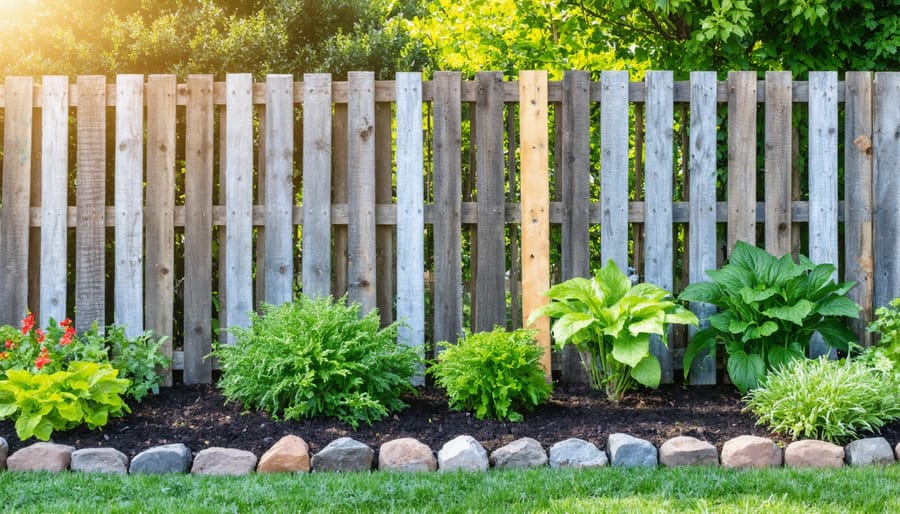Beautiful Garden Fences That Won’t Empty Your Wallet

Transform your garden boundary with budget-friendly backyard privacy solutions that combine style and functionality. Create natural fencing using fast-growing bamboo or ornamental grasses for under $100, delivering instant privacy without the cost of traditional materials. Repurpose pallets into striking fence panels by sanding, weatherproofing, and connecting them with basic hardware – a complete solution for less than $200. Install wire fencing supported by wooden posts and weave climbing plants through the mesh, creating a living wall that costs roughly half the price of conventional wooden fencing. These affordable alternatives not only secure your garden but also enhance its aesthetic appeal while working within tight budget constraints. Each design option emphasizes durability and easy maintenance, ensuring your investment provides lasting value without straining your finances.
Natural Material Fencing Solutions
Bamboo Barrier Beauty
Bamboo fencing offers a natural, eco-friendly solution that brings an exotic touch to your garden without breaking the bank. To create your bamboo barrier, start by sourcing materials from local garden centers or online marketplaces, where you can often find bamboo poles or ready-made bamboo fence rolls at reasonable prices.
For installation, begin by marking your fence line and installing support posts every 6-8 feet. Cedar or pressure-treated posts work well and should be buried at least 2 feet deep. Once your posts are secure, you can either attach bamboo fence rolls directly to them using galvanized wire or create your own design by securing individual bamboo poles vertically.
To enhance durability, treat your bamboo with a natural sealant or protective oil before installation. This step helps prevent weathering and extends the life of your fence. For added stability, consider creating a double row of bamboo poles, offsetting the second row slightly to eliminate gaps and increase privacy.
Maintenance is relatively simple – just clean your bamboo fence annually with a mild soap solution and soft brush. Check for any loose poles or wire connections during your inspection, and reapply sealant every 2-3 years. In colder climates, you might want to add a winter wrap to protect the bamboo from harsh weather.
With proper care, your bamboo fence can last 8-10 years while providing an attractive, natural screen for your garden.
Woven Branch Fencing
Woven branch fencing, also known as wattle fencing, offers a charming, rustic solution that costs virtually nothing but your time and effort. This traditional technique involves weaving flexible branches and twigs between upright posts to create a sturdy, natural barrier that blends seamlessly with your garden landscape.
To create your own woven branch fence, start by collecting long, flexible branches from trees like willow, hazel, or birch during their dormant season. You’ll need both thicker branches for posts (about 2 inches in diameter) and thinner, pliable ones for weaving. Install your posts roughly 2 feet deep and 2-3 feet apart, ensuring they’re firmly secured.
Begin weaving by laying horizontal branches between the posts, alternating over and under in a basket-weave pattern. Start from the bottom and work your way up, packing the branches tightly together. As you weave, occasionally tap down the horizontal branches with a rubber mallet to ensure a tight fit.
This natural fencing typically lasts 3-5 years, depending on your climate and the type of wood used. To extend its lifespan, consider treating the posts with natural preservatives and ensuring proper drainage around the base. While more time-intensive than other options, woven branch fencing creates a beautiful, eco-friendly boundary that adds character to any garden space.

Upcycled Material Fence Designs
Pallet Paradise
Transform your garden boundary with one of the most versatile repurposed garden materials: wooden pallets. This budget-friendly fencing solution combines sustainability with style, and you can complete the project in a weekend. Here’s how to create your pallet paradise:
First, collect clean, sturdy wooden pallets from local businesses or online marketplaces. Look for pallets marked “HT” (heat-treated) as these are safe for outdoor use. You’ll need enough to cover your desired fence length, plus a few extra for spare parts.
Start by preparing your pallets. Sand down rough edges and remove any loose nails or splinters. Apply a coat of exterior wood preservative to protect against moisture and insects. For added durability, consider using exterior paint or wood stain in your chosen color.
To install, begin by marking your fence line and positioning support posts every 6-8 feet. Concrete these posts securely into the ground. Once set, attach the pallets horizontally using galvanized screws and brackets. Ensure each pallet is level before securing it to the posts.
For extra stability and visual appeal, add cross-bracing between pallets where needed. You can customize your fence by adding climbing plants, hanging planters, or even creating built-in herb gardens within the pallet spaces.
To maintain your pallet fence, inspect it annually for any loose boards or signs of wear. Touch up the preservative or paint as needed, and ensure proper drainage around the base to prevent rot. With proper care, your pallet fence can last several years while adding rustic charm to your garden.

Reclaimed Wood Wonders
Creating a charming garden fence doesn’t have to drain your wallet, especially when you tap into the world of reclaimed wood. Start by checking local demolition sites, construction projects, or online marketplaces like Facebook Marketplace and Craigslist for discarded wooden materials. Old pallets, weathered barn wood, and dismantled deck boards can all find new life as unique fence components.
Before using reclaimed wood, inspect each piece carefully for rot, insect damage, or protruding nails. Clean the wood thoroughly and sand rough edges for safety. If you’re working with pallets, choose those marked “HT” (heat-treated) rather than those treated with chemicals.
Consider mixing different wood types and textures to create an intentionally rustic look. Vertical pallet boards can form the main fence structure, while weathered barn wood might serve as decorative top rails. For added stability, treat your reclaimed wood with a weather-resistant sealant to extend its lifespan.
Creative placement can transform imperfect pieces into design features. Use shorter boards to create an intentionally uneven top line, or arrange boards horizontally at varying depths for a three-dimensional effect. Remember that imperfections often add character – those knots, nail holes, and color variations tell a story and contribute to your fence’s unique charm.
Save hardware costs by reusing existing nails and screws when possible, but invest in quality exterior screws for crucial structural connections.
Living Fence Alternatives
Fast-Growing Hedge Options
Creating a natural privacy barrier with fast-growing hedges is one of the most cost-effective and eco-friendly garden features you can add to your yard. Privet hedges are excellent choices, growing up to 2 feet per year and providing dense coverage within just a few seasons. For those seeking quick results, Leyland Cypress offers impressive growth rates of 3-4 feet annually and thrives in most climates.
Bamboo provides an exotic touch while offering exceptional growth speed, though it’s important to choose clumping varieties rather than running types to prevent unwanted spread. Green Giant Thuja is another fantastic option, combining rapid growth with disease resistance and a naturally pleasing pyramidal shape.
For flowering options, consider Rose of Sharon or Forsythia, which not only create privacy but add seasonal color to your garden. These plants typically establish themselves quickly and require minimal maintenance beyond regular trimming.
When planting your hedge, space young plants about 2-3 feet apart for optimal coverage. The initial cost ranges from $10-30 per plant, making it an affordable alternative to traditional fencing. Most of these options thrive in zones 5-9 and require basic care like annual pruning and occasional fertilizing to maintain their healthy appearance and density.
Climbing Plant Supports
Climbing plants offer an economical and natural way to create beautiful fence coverage. Start with simple support structures like bamboo poles arranged in a grid pattern and secured with garden twine – a setup that costs just a few dollars per linear foot. For larger areas, create an effective trellis using pressure-treated lumber posts with galvanized wire mesh or string stretched between them.
Repurposed materials work wonderfully too. Old metal bed frames, cattle panels, or even fallen tree branches can become excellent climbing supports when properly secured. For temporary solutions, consider installing heavy-duty garden netting between existing fence posts or trees.
When selecting climbing plants, opt for fast-growing varieties like morning glories, clematis, or pole beans for quick coverage. These plants naturally weave through support structures, creating living walls that provide both privacy and visual interest. For year-round screening, consider evergreen climbers like ivy or jasmine.
To maximize growth and stability, install your supports before planting, ensuring they’re firmly anchored at least 18 inches into the ground. Space vertical supports no more than 6 feet apart to prevent sagging as plants mature. Remember to position supports slightly away from existing walls or fences to allow for air circulation and prevent moisture damage.
Regular maintenance of both plants and supports will ensure your living fence remains sturdy and attractive throughout the growing season.

Budget-Friendly Traditional Fencing
Wire Fence Solutions
Wire fencing offers one of the most cost-effective solutions for garden boundaries, combining durability with easy installation. Welded wire mesh, also known as garden fence panels, typically costs between $1-3 per square foot, making it an excellent budget-friendly choice. For smaller gardens, chicken wire provides an even more affordable option, though it’s best suited for keeping out small animals and supporting climbing plants.
To install wire fencing, start by setting sturdy posts every 6-8 feet. Metal T-posts are particularly economical and can be easily driven into the ground without concrete. For added stability in softer soil, consider using wooden posts for corners and gates. When stretching the wire between posts, use a fence stretcher tool or two pieces of wood to ensure even tension without warping.
For a more polished look, consider combining wire fencing with natural elements. Plant climbing vines like morning glories or clematis along the fence line, or install bamboo screens in front of the wire. This approach creates an attractive green barrier while maintaining the fence’s practical benefits.
Maintenance is minimal with wire fencing – simply check for rust spots annually and repair any sagging sections promptly. A quick spray with garden hose keeps the fence clean, while zinc-based spray can protect against rust in humid climates.
Budget-saving tip: Look for remnant rolls at hardware stores or farm supply shops, which often sell at discounted prices. You can also repurpose old wire fencing by straightening bent sections and repainting with rust-resistant coating.
Simple Post and Rail Designs
Post and rail fencing offers one of the most cost-effective solutions for garden boundaries while maintaining a classic, rustic charm. This traditional design consists of vertical posts set into the ground with horizontal rails connecting them, creating an open yet defined perimeter for your garden space.
The beauty of post and rail fencing lies in its simplicity and versatility. You can use pressure-treated lumber for longevity or opt for cedar if your budget allows. For the most economical approach, consider using rough-sawn timber, which costs significantly less than finished lumber while adding a natural, rustic appeal to your garden.
A basic two-rail design works well for most gardens, with posts spaced 6-8 feet apart. For added security or visual interest, you can add a third rail or incorporate some privacy screen ideas between posts where needed. The open design allows airflow and preserves views while clearly marking your property boundaries.
To keep costs down, consider these practical tips:
– Use concrete only for corner posts and gates
– Space posts at maximum recommended distances
– Choose locally sourced lumber
– Apply preservative treatment yourself
– Install during dry weather to avoid additional groundwork costs
With proper installation and maintenance, a simple post and rail fence can last 15-20 years while providing an attractive garden boundary that complements any landscape style. Regular inspection and occasional wood treatment will help extend its lifespan and maintain its appearance.
Creating an attractive and functional garden fence doesn’t have to break the bank. As we’ve explored, there are numerous budget-friendly options available, from natural bamboo barriers to upcycled pallet fencing and classic wire mesh designs. By choosing materials wisely and taking the DIY approach, you can save significantly while still achieving the garden boundary of your dreams.
Remember that proper planning is key to success. Take time to measure your space, consider your specific needs, and gather all necessary materials before beginning. Don’t forget to check local regulations and property lines, and always prioritize proper installation techniques to ensure your fence stands the test of time.
Whether you’re looking to create privacy, define garden spaces, or keep pets safely contained, there’s an affordable fencing solution that’s right for you. Start with a small section if you’re new to DIY projects, and don’t be afraid to mix different materials or designs to create something unique to your space.
With these budget-friendly ideas and installation tips in hand, you’re ready to transform your garden with a beautiful new fence that won’t strain your wallet.

